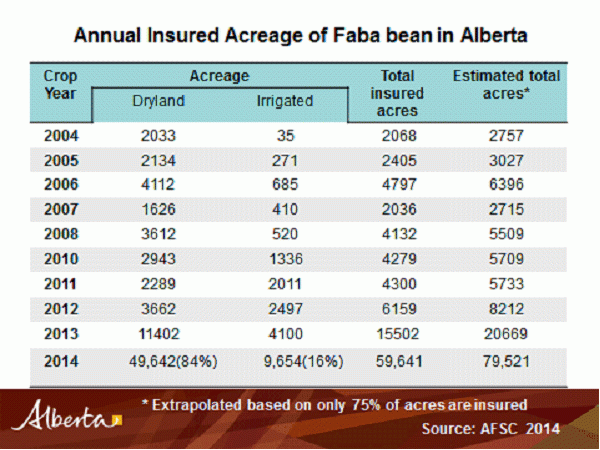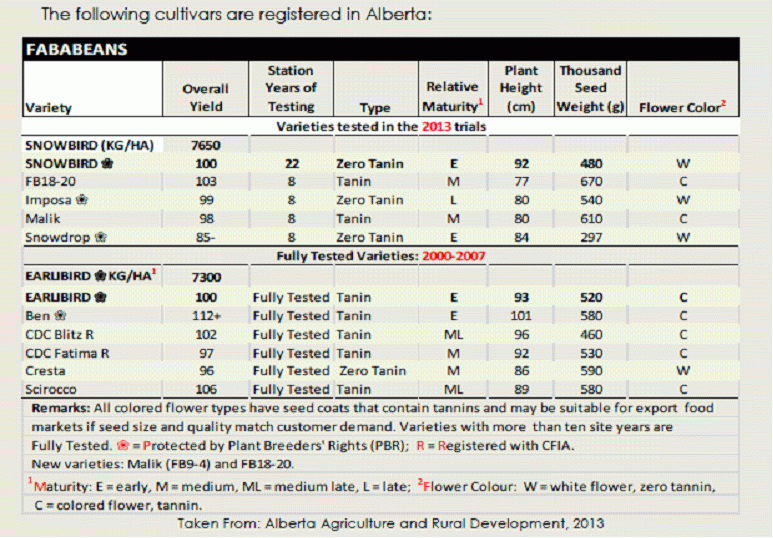Government mail service may be affected by the Canada Post labour disruption. Learn about how critical government mail will be handled.
Introduction
Faba bean is a pulse crop capable of growing in cool, wet environments and is used for both human and animal consumption. There are two types of faba bean varieties - tannin and low tannin (zero tannin). Tannins are anti-nutritive compounds that affect palatability and digestion in monogastrics. Tannin beans are desired for human consumption in both whole form or fractionated for use as a food ingredient. Low tannin beans, often referred to as zero tannin, can be used for both human and animal consumption.
Uses of faba bean
Edible beans
Faba beans, like other pulses, can be processed into protein, starch and fibre. They are high in protein (28-32%) compared to field peas (24%) and are low in oil. Faba beans are predominately exported to areas in the Mediterranean and the Middle East with Egypt being the largest consumer. Both tannin and low tannin varieties are in demand in worldwide food markets. Canning, sauces and falafel are common uses for both types of faba bean.
The fractionation of faba bean components has been explored. New varieties have been bred to have reduced levels of anti-nutritional qualities. Demand for non-genetically modified, high protein, gluten-free foods rich in micro-nutrients has made pulse crops, such as faba bean, valuable in the food fractions market.
Animal feed
Faba bean has the added benefit of being incorporated into animal feed rations if it does not meet the specifications for human consumption. Their low oil content means they do not need to be processed for oil extraction before being used for feed, like soybeans. Low tannin varieties can be fed to a variety of livestock such as hogs, dairy, beef cattle, lamb, poultry and even fish and buffalo. The table below shows the nutritional value of the faba bean.
Table 1: Nutritional Value of Faba Bean, Pead Seed and Soybean Meal
| Chemical Composition (%) | Faba bean Seed | Pea Seed | Soybean Meal |
|---|---|---|---|
| Dry Matter | 88.3 | 88.0 | 88.3 |
| Crude Protein | 25-30 | 23 | 49 |
| Crude Fibre | 7.8 | 5.5 | 6.1 |
| Starch | 32.7 | 46 | 6.0 |
Source: Pulse Canada and Alberta Faba Bean Producer's Manual 1.0
Production
Total insured acres nearly quadrupled from 2013 to 2014. In 2014, Saskatchewan and Manitoba grew approximately 15,000 and 5,000 acres respectively. Faba beans can be grown on both irrigated and dryland fields. The annual insured acres of Faba bean in Alberta are listed below.
Figure 1: Annual Insured Acreage of Faba Bean in Alberta

Since faba beans grow in cool, wet environments they can be seeded very early in the spring, giving farmers the ability to spread the work load during seeding. Seedlings are capable of withstanding temperatures as low as -3 degrees Celsius. Faba bean is a moisture loving crop, so they are not recommended for areas where there is little precipitation or no access to irrigation. They also have great standability which makes ease of harvest an additional benefit.
Below are a number of different cultivars that have been tested and are available in Alberta. These varieties can be purchased from local seed retailers throughout the province.
Figure 2: Cultivars Registered in Alberta

Nitrogen Fixation
Faba bean is the highest nitrogen fixing annual legume making it an excellent rotational crop. Faba bean can fix upwards of 90% of their own nitrogen requirements, which means less nitrogen fertilizer needs to be applied in the spring. There has been some anecdotal evidence that cereal crops following faba bean can see a yield increase of 10 to 15%. This could be a result of the nitrogen that is slowly released from the faba bean stubble.
Handling
Proper care in handling is critical especially if the beans are going to be sold for export. Damage to the beans can be very costly. Conveyor augers can help reduce seed damage. Lowering the distance from which the beans are dropped may also help protect the appearance of the seed. Careful handling can limit the amount of cracking and splitting.
Faba bean market
A well thought out marketing strategy is important before you consider growing this crop. Low tannin varieties are less risky to grow because they can be sold on both export human food and domestic animal feed markets. Tannin-containing varieties are riskier because they contain anti-nutritive compounds that can only be digested easily by ruminants (dairy or beef cattle) but not monogastrics such as swine or poultry. Therefore, they are only desired as ruminant feed if they do not meet edible-grade. Hence, most producers prefer to grow low tannin varieties.
There are a limited number of faba bean buyers in the western prairies. Merchants will generally export the beans whole or sell them to fractionating factories to create food ingredients for human consumption. Two companies in Alberta that are currently accepting faba bean are:
- Saskcan Pulse Trading – Gibbons, AB
- W.A. Grain & Pulse Solutions – Innisfail, AB
Quality
Physical appearance is one of the most important criteria for the beans to meet the standard for human food. For instance, physical appearance can be negatively impacted by insect damage, improper handling or improper storage, thus making them less desirable for human consumption. Some of the characteristics buyers look for that could result in a discounted price include:
- Blackened Seed Coats
- Cracks
- Discolouration
- Splits
- Sprouting
- Perforation
- Mould
- Fireburnt
- Odour
Contracts and pricing
Production contracts are available for producers from purchasing agents. However, because of the small overall production of faba bean, contracts are limited. Talking to a few faba bean merchants prior to planting the crop is highly recommended. Ensure a merchant has a market available for the variety you are contemplating growing.
Faba beans that are used for animal feed compete with soymeal, feed lentil, feed peas and canola meal as alternative protein sources. Faba bean is generally priced at approximately the same level as feed peas. Below are the prices reported by Parkland Alberta Commodities in 2013.
Table 2: Feed and Edible Faba bean Pricing 2013 ($/bushel)
| Month | Feed | Edible |
| September | $6.00 | $8.00 |
| October | $5.50 | $7.50 |
| November | $6.60 | $7.05 |
Try to sell your beans shortly after harvest. This is important because merchants typically try to ensure they deliver their product before the world market becomes flushed with faba beans from other countries. Major world competitors include the United Kingdom, France and Australia.
Summary
Faba beans have value in both human consumption and animal feed markets. They are a hardy crop and can be a valuable part of a crop rotation. Pricing options are available to faba bean producers, although it is important to discuss contract specifications with potential buyers ahead of time to ensure that there is a buyer for the product.